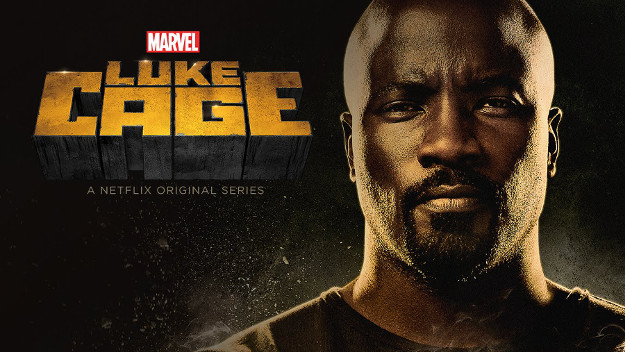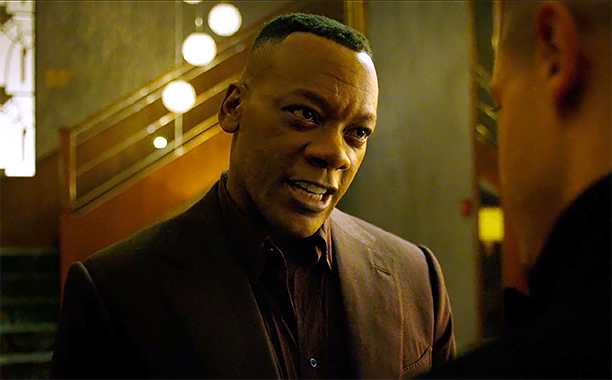‘A Different Picture’: What’s Next for Luke Cage?
This guest post is part of our new blog series on Comics, Race, and Society, edited by Julian Chambliss and Walter Greason.

In the aftermath of Donald Trump’s election, my immediate response was an incredibly depressed one. These feelings only deepened with such news as a sharp rise in racist attacks in the wake of the election, or children expressing fears for the safety of their parents and the unity of their family as a result of Donald Trump’s anti-immigrant views and beliefs such as that there should be a ‘total and complete shutdown of Muslims entering the United States.’ I thought about the genuine optimism with which I wrote – only at the beginning of this month– about the diversity of gendered and ethnic casting and the truly progressive racial politics of the 2016 Luke Cage. Writing just after this election and referring to the promise of Obama’s 2008 victory, NPR editors noted: “Eight years ago, the future of race relations in America looked, well, hopeful. Today, it’s a different picture.’
In the days that followed Trump’s victory, though, I started to put aside feelings of despair. This is a time for considered responses, not unfocused wailing, and the election of Donald Trump to the Presidency doesn’t have to be – shouldn’t be – the death knell for the progressive cultural politics espoused in Netflix’s Luke Cage. The NPR phrasing was right: there is ‘a different picture’; but it doesn’t have to be one that rejects the multiracial vision put forward by Luke Cage creator Cheo Hodari Coker.
To this end, I returned to the first volume of Luke Cage: Hero for Hire, to consider whether there were other stories – different pictures – that are as yet unexplored in the adaptation. (As I explained, the first season of the TV series was based solely on the first two issues of the first volume.) And in a world in which the incoming US Commander-in-Chief has repeatedly advocated repatriation and denounced immigration, are there interpretations of the original comic that could provide not only lessons for a reading public but a potentially productive opposition to the right-wing rhetoric of the incumbent political class? I would respond in the affirmative.
In issue #8 of the first volume of Luke Cage: Hero for Hire, the protagonist faces a threat that at first glance appears to arrive on three fronts. Whereas previous issues have pitted him against a single villain – like Willis ‘Diamondback’ Stryker, whose storyline made it onto TV in 2016 – this episode is different: he is either assaulted or starts an attack in three distinct directions. He is hired by a mysterious European individual to target a group of warehouse workers, he tracks down a criminal (one Georgie Simms) from a previous issue in the volume, and he comes face-to-face with an obvious super-villain: the armor-clad, cape-wearing, forebodingly monikered Doctor Doom.

Quickly, though, it turns out all is not as it seems. While Doctor Doom is presented as a villain – both visually, with an aggressive stance and a dramatic costume, and aurally, in the way that speech bubbles show his shouting of his stereotypically evil name – he in fact explains that he was behind the European man’s initial approach of Cage and is actually on the side of the ‘Hero for Hire.’ In spite of his villainous presentation, this antagonist is apparently keen to join forces with Cage.
This gesture towards cooperative intent is by no means unheard of in the world of superheroes — nor even in the world of Luke Cage. In the 2016 TV series, Luke agrees to an alliance with two of his erstwhile opponents (the corrupt politician Mariah Dillard and the gangster Hernan ‘Shades’ Álvarez) in order to defeat Diamondback, their common foe. It is strange, however, for this cooperation to be suggested at the very first meeting between a protagonist and an antagonist; and it makes this meeting a prime candidate for future adaptation.

However, it is not only the narrative interest generated by this union between apparently opposed characters that makes Doom’s appearance of interest. The pervasiveness of the character is significant. In the course of this and subsequent issues, we learn that the multiple threats faced by Cage at the start of the current issue all actually stem from one source: Doom himself. In interrogating Georgie Simms after he fails in attempting to kill Cage, Luke finds out that the gangster was involved in a murder from earlier in the volume, which is eventually linked to Doom; and the European gentleman who sends him to the warehouse is one of Doom’s henchmen. Moreover, Doom himself is not what he seems, as he has no intention of paying Cage for his services in attacking the warehouse workers.
The identity of these warehouse workers is interesting. They are African-American men, and the environment in which they live is introduced using animalizing language, establishing a racially dismissive climate from the outset: captions explain that Luke ventures ‘into the worlds of people who call New York an animal, and live off it like tapeworms’ (Luke Cage: Hero for Hire, vol. 1, #8, 10.1). The ultimate act of ‘othering,’ however, is not linguistic but narrative. When Luke attacks the gang he is surprised by their stamina and willingness to keep fighting in spite of their adversary’s strength; he only discovers the reason for this when one of his blows shatters the face of one of the workers, and circuit boards and wires are revealed: Doom’s targets were robots.
 This is intriguing. The 1972 comic, coming as the world – and America in particular – entered an era of technological progression and increasingly mechanized labor, unifies fears about these computerized advances with a mistrust of a racial ‘other’ that was making strides in social and political circles at the time: from the 1968 Fair Housing Act’s legislation against normalized racial discrimination, to the Supreme Court’s 1971 landmark decision to uphold the busing of students for integration in Charlotte, NC, or Shirley Chisolm’s 1972 run as the first major-party African-American candidate for US President (after her election to Congress in 1968).
This is intriguing. The 1972 comic, coming as the world – and America in particular – entered an era of technological progression and increasingly mechanized labor, unifies fears about these computerized advances with a mistrust of a racial ‘other’ that was making strides in social and political circles at the time: from the 1968 Fair Housing Act’s legislation against normalized racial discrimination, to the Supreme Court’s 1971 landmark decision to uphold the busing of students for integration in Charlotte, NC, or Shirley Chisolm’s 1972 run as the first major-party African-American candidate for US President (after her election to Congress in 1968).
Luke’s ‘stark, staring, stultifying amazement’ at the discovery of the workers’ identity is shared by the audience. In the case of the non-African-American readers of the comic, however, this consternation could have had two sides: it reveals the extent to which black communities were viewed as less than human by an overwhelmingly white establishment.
The narrative thread involving working African-American men and robotics, then, is another contender for adaptation — and a particularly important one. Pursuing this story line in a modern setting would have interesting consequences, both for ideas of cultural representation and for students of contemporary American history. If Cheo Hodari Coker, his fellow show-runners, and producers can construct a narrative that follows concomitant thoughts about computerization and racial inequality, then it may well be possible for the TV adaptation of the comic to interrogate the twin issues of economic disenfranchisement and racist politics that so dominated the rhetoric of Donald Trump’s 2016 election.
Until these two trains of thought are united, the responses to this presidency are too often going to fall into an unproductive polarity: either anti-Trump protests or pro-Trump celebration, with neither side allowing contact with the other. When a lack of communication may be one of the reasons America got into this position in the first place, vocally and simultaneously addressing the economic and racial concerns of many of those involved may be one way forward. However, it starts with a continuation of this progressive comic adaptation. Now, more than ever, culture matters.
Sam Knowles is a teacher, lecturer, and writer specializing in the study of race and form in culture. His first book, Travel Writing and the Transnational Author, was published by Palgrave in 2014. A forthcoming research project will consider the political histories of a number of transnational island spaces. He is also pursuing research into the uses of graphic novel/comic form in representing the political and social complexities of postcolonial existences. Follow him on Twitter @life_academic.
Copyright © AAIHS. May not be reprinted without permission.
I could not agree with you more. My grandsons turned me onto Luke Cage and honestly I enjoy it. An African American Super Hero is more than just a notion and is not just in the comic books anymore!!